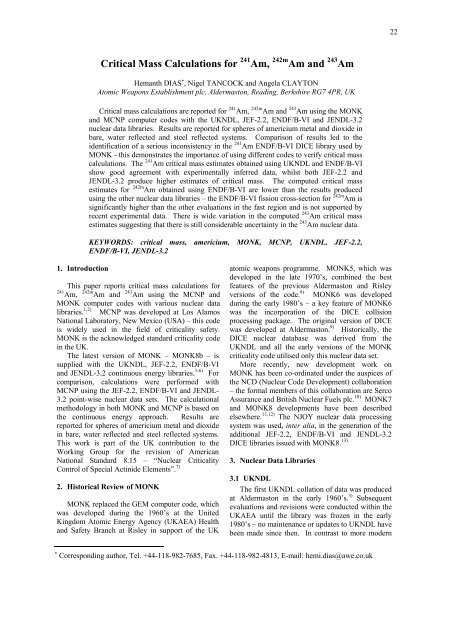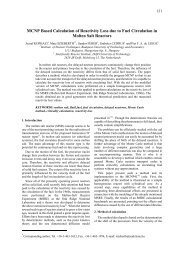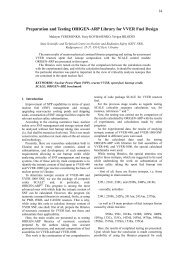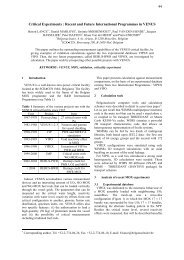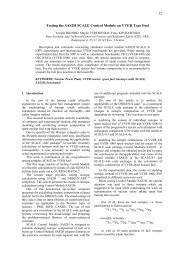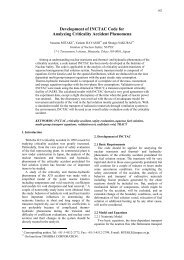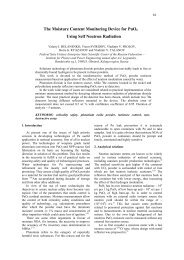Critical Mass Calculations for 241Am, 242mAm and 243Am
Critical Mass Calculations for 241Am, 242mAm and 243Am
Critical Mass Calculations for 241Am, 242mAm and 243Am
Create successful ePaper yourself
Turn your PDF publications into a flip-book with our unique Google optimized e-Paper software.
22<br />
<strong>Critical</strong> <strong>Mass</strong> <strong>Calculations</strong> <strong>for</strong> 241 Am, 242m Am <strong>and</strong> 243 Am<br />
Hemanth DIAS ∗ , Nigel TANCOCK <strong>and</strong> Angela CLAYTON<br />
Atomic Weapons Establishment plc, Aldermaston, Reading, Berkshire RG7 4PR, UK<br />
<strong>Critical</strong> mass calculations are reported <strong>for</strong> 241 Am, 242m Am <strong>and</strong> 243 Am using the MONK<br />
<strong>and</strong> MCNP computer codes with the UKNDL, JEF-2.2, ENDF/B-VI <strong>and</strong> JENDL-3.2<br />
nuclear data libraries. Results are reported <strong>for</strong> spheres of americium metal <strong>and</strong> dioxide in<br />
bare, water reflected <strong>and</strong> steel reflected systems. Comparison of results led to the<br />
identification of a serious inconsistency in the 241 Am ENDF/B-VI DICE library used by<br />
MONK - this demonstrates the importance of using different codes to verify critical mass<br />
calculations. The 241 Am critical mass estimates obtained using UKNDL <strong>and</strong> ENDF/B-VI<br />
show good agreement with experimentally inferred data, whilst both JEF-2.2 <strong>and</strong><br />
JENDL-3.2 produce higher estimates of critical mass. The computed critical mass<br />
estimates <strong>for</strong> 242m Am obtained using ENDF/B-VI are lower than the results produced<br />
using the other nuclear data libraries – the ENDF/B-VI fission cross-section <strong>for</strong> 242m Am is<br />
significantly higher than the other evaluations in the fast region <strong>and</strong> is not supported by<br />
recent experimental data. There is wide variation in the computed 243 Am critical mass<br />
estimates suggesting that there is still considerable uncertainty in the 243 Am nuclear data.<br />
KEYWORDS: critical mass, americium, MONK, MCNP, UKNDL, JEF-2.2,<br />
ENDF/B-VI, JENDL-3.2<br />
1. Introduction<br />
This paper reports critical mass calculations <strong>for</strong><br />
241 Am, 242m Am <strong>and</strong> 243 Am using the MCNP <strong>and</strong><br />
MONK computer codes with various nuclear data<br />
libraries. 1,2) MCNP was developed at Los Alamos<br />
National Laboratory, New Mexico (USA) – this code<br />
is widely used in the field of criticality safety.<br />
MONK is the acknowledged st<strong>and</strong>ard criticality code<br />
in the UK.<br />
The latest version of MONK – MONK8b – is<br />
supplied with the UKNDL, JEF-2.2, ENDF/B-VI<br />
<strong>and</strong> JENDL-3.2 continuous energy libraries. 3-6) For<br />
comparison, calculations were per<strong>for</strong>med with<br />
MCNP using the JEF-2.2, ENDF/B-VI <strong>and</strong> JENDL-<br />
3.2 point-wise nuclear data sets. The calculational<br />
methodology in both MONK <strong>and</strong> MCNP is based on<br />
the continuous energy approach. Results are<br />
reported <strong>for</strong> spheres of americium metal <strong>and</strong> dioxide<br />
in bare, water reflected <strong>and</strong> steel reflected systems.<br />
This work is part of the UK contribution to the<br />
Working Group <strong>for</strong> the revision of American<br />
National St<strong>and</strong>ard 8.15 – “Nuclear <strong>Critical</strong>ity<br />
Control of Special Actinide Elements”. 7)<br />
2. Historical Review of MONK<br />
MONK replaced the GEM computer code, which<br />
was developed during the 1960’s at the United<br />
Kingdom Atomic Energy Agency (UKAEA) Health<br />
<strong>and</strong> Safety Branch at Risley in support of the UK<br />
atomic weapons programme. MONK5, which was<br />
developed in the late 1970’s, combined the best<br />
features of the previous Aldermaston <strong>and</strong> Risley<br />
versions of the code. 8) MONK6 was developed<br />
during the early 1980’s – a key feature of MONK6<br />
was the incorporation of the DICE collision<br />
processing package. The original version of DICE<br />
was developed at Aldermaston. 9) Historically, the<br />
DICE nuclear database was derived from the<br />
UKNDL <strong>and</strong> all the early versions of the MONK<br />
criticality code utilised only this nuclear data set.<br />
More recently, new development work on<br />
MONK has been co-ordinated under the auspices of<br />
the NCD (Nuclear Code Development) collaboration<br />
– the <strong>for</strong>mal members of this collaboration are Serco<br />
Assurance <strong>and</strong> British Nuclear Fuels plc. 10) MONK7<br />
<strong>and</strong> MONK8 developments have been described<br />
elsewhere. 11,12) The NJOY nuclear data processing<br />
system was used, inter alia, in the generation of the<br />
additional JEF-2.2, ENDF/B-VI <strong>and</strong> JENDL-3.2<br />
DICE libraries issued with MONK8. 13)<br />
3. Nuclear Data Libraries<br />
3.1 UKNDL<br />
The first UKNDL collation of data was produced<br />
at Aldermaston in the early 1960’s. 3) Subsequent<br />
evaluations <strong>and</strong> revisions were conducted within the<br />
UKAEA until the library was frozen in the early<br />
1980’s – no maintenance or updates to UKNDL have<br />
been made since then. In contrast to more modern<br />
∗ Corresponding author, Tel. +44-118-982-7685, Fax. +44-118-982-4813, E-mail: hemi.dias@awe.co.uk
data evaluations, the UKNDL is “adjusted”;<br />
i.e. certain nuclear data were adjusted, based on<br />
experimental evidence, to ensure that computer<br />
calculations show good agreement (or are<br />
pessimistic) when compared with experimental data.<br />
Although only the 241 Am evaluation was <strong>for</strong>mally<br />
published, the last UKNDL americium evaluations<br />
were all produced at Harwell. 14) Details of the 243 Am<br />
neutron data evaluation, parts of which were adopted<br />
in JEF-2.2, can be downloaded from the Los Alamos<br />
T-2 Nuclear In<strong>for</strong>mation Service. 15)<br />
3.2 JEF-2.2<br />
The JEF-2.2 nuclear data library is described in<br />
JEFF Report 17. 4) The JEF-2.2 DICE library was<br />
frozen in 1996 to allow benchmarking studies. More<br />
specific details of the JEF-2.2 americium evaluations<br />
can be downloaded from the T-2 Nuclear<br />
In<strong>for</strong>mation Service. 15)<br />
3.3 ENDF/B-VI<br />
The ENDF/B-VI data evaluations have been<br />
periodically up-dated – the latest version available<br />
from the NEA is release 8. The T-2 Nuclear<br />
In<strong>for</strong>mation Service provides full details of the<br />
various evaluations in ENDF/B-VI. 15)<br />
The CENDL-2 evaluation of the neutron nuclear<br />
data <strong>for</strong> 241 Am was adopted in release 2. 16) This<br />
evaluation was revised <strong>for</strong> issue as release 3 by<br />
Young <strong>and</strong> Madl<strong>and</strong>. 15) The 241 Am evaluation is<br />
unchanged since ENDF/B-VIr3.<br />
Apart from the addition of the delayed fission<br />
neutron spectrum in release 1, the ENDF/B-VI<br />
242m Am evaluation is still unchanged from<br />
ENDF/B-V. 15,17)<br />
The ENDF/B-V 243 Am evaluation was due to<br />
Mann et al. 18) The cross section data were updated<br />
<strong>for</strong> ENDF/B-VIr1 by Weston. 15) In 1996 a new<br />
evaluation of the neutron data <strong>for</strong> 243 Am was issued<br />
as ENDF/B-VIr5 – this was prepared by Young <strong>and</strong><br />
Weston. 15) The 243 Am evaluation is unchanged since<br />
ENDF/B-VIr5.<br />
3.4 JENDL-3.2<br />
The 241 Am <strong>and</strong> 243 Am data <strong>for</strong> JENDL-2 were<br />
evaluated by Kikuchi. 19) The 242m Am evaluation <strong>for</strong><br />
JENDL-2 was by Nakagawa <strong>and</strong> Igarasi. 20) These<br />
data were revised <strong>for</strong> JENDL-3.2 by Nakagawa. 21)<br />
4. Results<br />
Tables 1-3 give the computed minimum critical<br />
masses of 241 Am, 242m Am <strong>and</strong> 243 Am, respectively.<br />
Results are reported <strong>for</strong> spheres of full density<br />
americium metal <strong>and</strong> dioxide in bare, water reflected<br />
(30cm) <strong>and</strong> 304 stainless steel reflected (20cm)<br />
systems. The densities of americium metal <strong>and</strong><br />
dioxide are based on the compilation by Haire. 22)<br />
Note that the ENDF/B-VI DICE library issued<br />
with MONK is release 4. 2) Consequently, the<br />
MONK ENDF/B-VI DICE library should contain the<br />
most recent evaluations <strong>for</strong> 241 Am <strong>and</strong> 242m Am – but<br />
not the latest (release 5) evaluation <strong>for</strong> 243 Am (see<br />
Section 3.3).<br />
The MCNP calculations <strong>for</strong> 241 Am <strong>and</strong> 242m Am<br />
used the latest version of ENDF/B-VI available from<br />
the NEA – release 8. So as to facilitate comparison<br />
with the MONK results, the results presented in<br />
Table 3 were obtained using the ENDF/B-VIr1<br />
243 Am evaluation. The 243 Am results obtained using<br />
ENDF/B-VIr8 (i.e. including the latest evaluation <strong>for</strong><br />
243 Am – release 5) are shown in parentheses.<br />
5. Discussion<br />
The results presented in Table 1 show significant<br />
differences between the MONK <strong>and</strong> MCNP<br />
calculations <strong>for</strong> 241 Am using ENDF/B-VI. Other<br />
workers have reported minimum critical mass<br />
calculations <strong>for</strong> bare 241 Am metal - a value of<br />
57.01kg is quoted using ENDF/B-VIr6. 23) This<br />
reported value of the critical mass compares<br />
favourably with the MCNP calculation, but is<br />
inconsistent with the MONK result given in Table 1.<br />
This suggests that the MONK results <strong>for</strong> 241 Am<br />
using ENDF/B-VI may be in error.<br />
Table 1 Computed Minimum <strong>Critical</strong> <strong>Mass</strong> of 241 Am<br />
<strong>Critical</strong> mass (kg)<br />
Chemical Reflector<br />
MONK<br />
MCNP<br />
<strong>for</strong>m<br />
UKNDL JEF-2.2 ENDF/B-<br />
VI<br />
JENDL-<br />
3.2<br />
JEF-2.2 ENDF/<br />
B-VI<br />
JENDL-<br />
3.2<br />
Metal Bare 56.4 75.7 88.0 * 76.1 73.3 57.7 73.7<br />
ρ = 13.66 Water 50.9 68.3 79.9 * 69.2 65.8 52.0 66.7<br />
g/cm 3 Steel 33.6 42.4 51.8 * 45.4 40.9 33.8 43.6<br />
Dioxide Bare 98.2 132 161 * 135 129 94.6 131<br />
ρ = 11.69 Water 92.0 124 151 * 125 120 87.6 123<br />
g/cm 3 Steel 65.4 86.0 109 * 91.4 83.9 62.4 89.0<br />
* MONK results <strong>for</strong> ENDF/B-VI are subject to error – see text.
Table 2 Computed Minimum <strong>Critical</strong> <strong>Mass</strong> of 242m Am<br />
<strong>Critical</strong> mass (kg)<br />
Chemical Reflector<br />
MONK<br />
MCNP<br />
<strong>for</strong>m<br />
UKNDL JEF-2.2 ENDF/B-<br />
VI<br />
JENDL-<br />
3.2<br />
JEF-2.2 ENDF/<br />
B-VI<br />
JENDL-<br />
3.2<br />
Metal Bare 13.0 13.9 8.96 12.3 14.2 9.06 12.5<br />
ρ = 13.72 Water 4.59 4.69 3.23 4.38 4.78 3.25 4.45<br />
g/cm 3 Steel 5.21 5.11 3.73 4.97 5.21 3.74 5.02<br />
Dioxide Bare 14.1 14.8 9.96 13.4 15.0 10.0 13.6<br />
ρ = 11.73 Water 5.23 5.34 3.74 5.04 5.39 3.74 5.08<br />
g/cm 3 Steel 6.04 5.86 4.42 5.79 6.03 4.44 5.85<br />
Table 3 Computed Minimum <strong>Critical</strong> <strong>Mass</strong> of 243 Am<br />
<strong>Critical</strong> mass (kg)<br />
Chemical Reflector<br />
MONK<br />
MCNP<br />
<strong>for</strong>m<br />
UKNDL JEF-2.2 ENDF/B<br />
-VI<br />
JENDL-<br />
3.2<br />
JEF-2.2 ENDF/<br />
B-VI<br />
JENDL-<br />
3.2<br />
Metal Bare 181 217 222 296 206 211 (143) * 284<br />
ρ = 13.77 Water 165 200 205 277 189 194 (132) * 262<br />
g/cm 3 Steel 111 133 144 193 127 135 (89.0) * 181<br />
Dioxide Bare 473 616 618 926 578 572 (300) * 864<br />
ρ = 11.77 Water 450 593 599 876 558 553 (282) * 822<br />
g/cm 3 Steel 342 456 467 698 429 438 (215) * 662<br />
* Results in parentheses are <strong>for</strong> the ENDF/B-VIr8 evaluation – see text.<br />
Following discussions with Serco Assurance, it is<br />
apparent that difficulties were encountered during<br />
the creation of the ENDF/B-VI DICE library <strong>for</strong><br />
241 Am. 24) The ENDF/B-VIr3<br />
241 Am evaluation<br />
utilised the Madl<strong>and</strong>-Nix fission spectrum<br />
representation. 25) The version of NJOY then<br />
available at Serco Assurance was unable to deal with<br />
this representation of the fission spectrum. [The<br />
Madl<strong>and</strong>-Nix fission spectrum representation is not<br />
normalised to unity – the spectrum has to be renormalised<br />
prior to processing into a <strong>for</strong>m suitable<br />
<strong>for</strong> Monte Carlo analysis. 24) ]<br />
Nuclear data sets may be readily compared using<br />
the JANIS display program. 26) The 241 Am fission<br />
neutron spectrum was abstracted from the ENDF/B-<br />
VI DICE library in a <strong>for</strong>m compatible with JANIS. 24)<br />
Note that the fission spectrum held in DICE is<br />
simulated by a number of equiprobable ranges i.e.<br />
the energy distribution is approximated by a<br />
histogram with intervals chosen so that there is an<br />
equal area under the histogram in each interval. 9)<br />
The 241 Am fission neutron spectra from ENDF/B-<br />
VI DICE, ENDF/B-VIr2, ENDF/B-VIr3 <strong>and</strong> JEF-2.2<br />
were compared using JANIS - see Fig. 1. The<br />
ENDF/B-VI DICE fission spectrum <strong>for</strong> 241 Am is a<br />
good representation of the JEF-2.2 evaluation, but is<br />
significantly different from the ENDF/B-VIr2 <strong>and</strong><br />
ENDF/B-VIr3 evaluations – see Fig. 1. Based upon<br />
the evidence presented in Fig. 1, it is clear that the<br />
JEF-2.2 fission spectrum <strong>for</strong><br />
241 Am has been<br />
substituted <strong>for</strong> the ENDF/B-VIr3 evaluation in the<br />
ENDF/B-VI DICE library. The ENDF/B-VI DICE<br />
library <strong>for</strong> 241 Am is subject to error <strong>and</strong> is there<strong>for</strong>e<br />
unsuitable <strong>for</strong> critical mass calculations – the MONK<br />
results <strong>for</strong> ENDF/B-VI presented in Table 1 will not<br />
be considered further in this analysis.<br />
Fig. 1<br />
241 Am fission neutron spectra
The 241 Am minimum critical mass calculations<br />
fall into two groups – the higher critical mass<br />
estimates are obtained using JEF-2.2 <strong>and</strong> JENDL-3.2,<br />
whilst UKNDL <strong>and</strong> ENDF/B-VI yield lower critical<br />
mass estimates (Table 1). The JEF-2.2 results <strong>for</strong><br />
241 Am metal in bare, water reflected <strong>and</strong> steel<br />
reflected systems show good agreement with<br />
calculations reported by Duluc <strong>and</strong> Anno. 27) The<br />
JENDL-3.2 results <strong>for</strong> 241 Am metal <strong>and</strong> dioxide in<br />
bare <strong>and</strong> water reflected systems compare favourably<br />
with the data reported by Nojiri <strong>and</strong> Fukasaku. 28)<br />
<strong>Critical</strong> masses of 241 Am have been inferred from<br />
reactivity coefficient measurements in fast critical<br />
assemblies. 29,30) The inferred critical mass estimates<br />
are as follows: 58kg – bare system; 51kg – water<br />
reflected; <strong>and</strong> 34kg – steel reflected. The computed<br />
results obtained using UKNDL <strong>and</strong> ENDF/B-VI are<br />
in excellent agreement with the experimentally<br />
inferred data – Table 1. Note that the UKNDL<br />
nuclear data may have been “adjusted” to ensure<br />
agreement with these experimental data (see Section<br />
3.1).<br />
There are differences between the results<br />
presented in Table 1 <strong>and</strong> 241 Am bare critical mass<br />
calculations reported by Brewer et al. 31) However,<br />
these workers assumed a density of 11.7g/cm 3 in<br />
their study which seems to correspond to that of<br />
AmO 2 , rather than americium metal.<br />
The 242m Am calculations with the UKNDL, JEF-<br />
2.2 <strong>and</strong> JENDL-3.2 nuclear data libraries compare<br />
reasonably well, although the JEF-2.2 <strong>and</strong> JENDL-<br />
3.2 critical mass estimates obtained using MONK<br />
are slightly lower than those computed using MCNP<br />
– Table 2. The JENDL-3.2 results <strong>for</strong> 242m Am metal<br />
in bare, water reflected <strong>and</strong> steel reflected systems<br />
show good agreement with the data reported by<br />
Okuno <strong>and</strong> Kawasaki. 32) There are discrepancies<br />
between the results given in Table 2 <strong>and</strong> the data<br />
reported by Duluc <strong>and</strong> Anno. 27) In particular, these<br />
authors claim that the critical mass of water reflected<br />
242m Am metal obtained using JEF-2.2 is ~6.5kg –<br />
this critical mass estimate is inconsistent with the<br />
results presented in Table 2 <strong>and</strong> should be treated<br />
with caution.<br />
The ENDF/B-VI<br />
242m Am critical mass<br />
calculations are significantly lower than the results<br />
obtained using the other nuclear data libraries –<br />
Table 2. For example, calculations using UKNDL,<br />
JEF-2.2 <strong>and</strong> JENDL-3.2 give bare 242m Am minimum<br />
critical mass estimates in the range 12.3 – 14.2kg,<br />
whereas the bare 242m Am critical mass obtained using<br />
ENDF/B-VI is ~ 9kg. The ENDF/B-VI 242m Am<br />
fission cross section is significantly higher than the<br />
UKNDL, JEF-2.2 <strong>and</strong> JENDL-3.2 evaluations in the<br />
fast energy region (by ~ 50% at 1MeV) <strong>and</strong> is not<br />
supported by recent experimental data. 33,34) The<br />
242m Am critical mass estimates calculated using<br />
ENDF/B-VI should there<strong>for</strong>e be considered spurious.<br />
There is wide variation in the computed<br />
minimum critical mass estimates <strong>for</strong> 243 Am – Table 3.<br />
<strong>Calculations</strong> using the JEF-2.2 <strong>and</strong> ENDF/B-VIr1<br />
data libraries compare favourably, whilst the<br />
UKNDL gives lower estimates of the 243 Am critical<br />
mass. The largest estimates of 243 Am critical mass<br />
are obtained using JENDL-3.2. The JEF-2.2 results<br />
<strong>for</strong> 243 Am metal in bare, water reflected <strong>and</strong> steel<br />
reflected systems compare favourably with<br />
computations reported by Duluc <strong>and</strong> Anno. 27) The<br />
JENDL-3.2 results <strong>for</strong> 243 Am metal <strong>and</strong> dioxide in<br />
bare <strong>and</strong> water reflected systems are in reasonable<br />
agreement with the data reported by Nojiri <strong>and</strong><br />
Fukasaku. 28)<br />
There are large differences between the 243 Am<br />
critical mass results obtained using the ENDF/B-<br />
VIr1 evaluation <strong>and</strong> those obtained using ENDF/B-<br />
VIr8 – Table 3. For 243 Am metal the ENDF/B-VIr8<br />
results are ~33% lower than the ENDF/B-VIr1<br />
calculations. For 243 Am dioxide the ENDF/B-VIr8<br />
results are ~50% lower than those obtained using<br />
ENDF/B-VIr1. The results presented in Table 3<br />
suggest that the nuclear data <strong>for</strong> 243 Am are still<br />
subject to considerable uncertainty.<br />
As noted in Section 2, the DICE nuclear database<br />
was originally derived from the UKNDL. Secondary<br />
neutron energy data were defined <strong>for</strong> different<br />
incident neutron energy ranges. In more modern<br />
nuclear data libraries, the secondary data are<br />
commonly defined at a series of incident energy<br />
points – data <strong>for</strong> intermediate incident neutron<br />
energies are then obtained by linear interpolation.<br />
Interestingly, although MONK is now issued with<br />
JEF-2.2, ENDF/B-VI <strong>and</strong> JENDL-3.2 DICE libraries,<br />
DICE has not yet been updated to per<strong>for</strong>m this<br />
interpolation. 24) For most major actinides any effect<br />
will be insignificant because the secondary data are<br />
well characterised. For some minor actinides the<br />
secondary data are occasionally more coarsely<br />
defined <strong>and</strong> errors may be introduced if the current<br />
DICE representation of the secondary data is used.<br />
For example, the ENDF/B-VI 242m Am fission<br />
spectrum is defined at four incident energies:<br />
1x10 -5 eV, 4MeV, 7MeV <strong>and</strong> 20MeV. The current<br />
version of DICE uses the thermal fission spectrum<br />
up to 4MeV, the 4MeV spectrum up to 7MeV, <strong>and</strong><br />
the 7MeV spectrum up to 15MeV. [The DICE<br />
energy grid does not extend beyond 15MeV. 9) ] The<br />
242m Am fission spectra were abstracted from the<br />
ENDF/B-VI DICE library in a <strong>for</strong>m compatible with<br />
JANIS. 24) The JANIS display program was then<br />
used to compare the fission spectra at these incident<br />
neutron energies – see Fig. 2. Close examination<br />
reveals only barely discernible variations in the<br />
fission spectra (Fig. 2). All the other americium<br />
evaluations considered herein are either well<br />
characterised or show barely discernible variations in<br />
the fission spectra. It follows that the DICE
Fig. 2<br />
242m Am fission neutron spectra<br />
representation of secondary data is unlikely to<br />
introduce any major source of error in the critical<br />
mass calculations reported herein.<br />
6. Conclusion<br />
Minimum critical mass calculations are reported<br />
<strong>for</strong> 241 Am, 242m Am <strong>and</strong> 243 Am using the MONK <strong>and</strong><br />
MCNP computer codes with the UKNDL, JEF-2.2,<br />
ENDF/B-VI <strong>and</strong> JENDL-3.2 nuclear data libraries.<br />
Results are reported <strong>for</strong> spheres of americium metal<br />
<strong>and</strong> dioxide in bare, water reflected <strong>and</strong> stainless<br />
steel reflected systems.<br />
Acknowledgements<br />
The authors wish to thank Mr C. Dean (Serco<br />
Assurance) <strong>for</strong> the provision of 241 Am <strong>and</strong> 242m Am<br />
fission spectra abstracted from the MONK ENDF/B-<br />
VI DICE library <strong>and</strong> <strong>for</strong> useful advice. Mr K. Cooke<br />
(AWE) assisted with the computational processing<br />
of data.<br />
© British Crown Copyright 2003/MOD. Published with<br />
the permission of the Controller of Her Britannic<br />
Majesty’s Stationery Office.<br />
References<br />
1) J. F. Briesmeister (Ed.), “MCNP – A General<br />
Monte Carlo N-Particle Transport Code”,<br />
Version 4C, Los Alamos National Laboratory<br />
Report LA-13709-M (2000).<br />
2) M. J. Armishaw, “An Introduction to the New<br />
Features of MONK Version 8B,<br />
ANSWERS/MONK/REPORT/001, Serco<br />
Assurance (2001).<br />
3) K. Parker, “The Aldermaston Nuclear Data<br />
Library as at May 1963”, Atomic Weapons<br />
Research Establishment Report No. O –70/63,<br />
UKAEA, 1965.<br />
4) Nuclear Energy Agency, “The JEF-2.2 Nuclear<br />
Data Library”, JEFF Report 17, OECD (2000).<br />
5) V. McLane, “ENDF-102 Data Formats <strong>and</strong><br />
Procedures <strong>for</strong> the Evaluated Nuclear Data File<br />
ENDF-6”, Brookhaven National Laboratory<br />
Report BNL-NCS-44945-01/04 (2001).<br />
6) T. Nakagawa, K. Shibata, S. Chiba, T.<br />
Fukahori, Y. Nakajima, Y. Kikuchi, T.<br />
Kawano, Y. K<strong>and</strong>a, T. Ohsawa, H. Matsunobu,<br />
M. Kawai, A. Zukeran, T Watanabe, S. Igarasi,<br />
K. Kosako <strong>and</strong> T. Asami, “Japanese Evaluated<br />
Nuclear Data Library Version 3 Revision-2:<br />
JENDL-3.2”, J. Nucl. Sci. Technol., 32, 1259<br />
(1995).<br />
7) American National St<strong>and</strong>ards Institute,<br />
“Nuclear <strong>Critical</strong>ity Control of Special<br />
Actinide Elements”, ANSI/ANS-8.15,<br />
American Nuclear Society (1981).<br />
8) V. S. W. Sherriffs, “MONK – A General<br />
Purpose Monte Carlo Neutronics Program”,<br />
Safety <strong>and</strong> Reliability Directorate Report SRD<br />
R 86, UKAEA (1978).<br />
9) J. B. Parker (Ed.), “DICE Mk. V – The<br />
Preparation of Nuclear Data into a Form<br />
Suitable <strong>for</strong> Monte Carlo <strong>Calculations</strong> Using an<br />
Electronic Computer”, Atomic Weapons<br />
Research Establishment Report No. O – 27/66,<br />
UKAEA (1966).<br />
10) R. J. Brissenden, “The Next Generation of<br />
MONK7 <strong>Critical</strong>ity Code”, Proc. Int. Conf. on<br />
Nuclear <strong>Critical</strong>ity Safety, ICNC’91, Ox<strong>for</strong>d,<br />
Sept. 9-13, 1991, 3, 15 (1991).<br />
11) N. R. Smith <strong>and</strong> G. A. Morrell, “An<br />
Introduction to MONK7”, Proc. Int. Conf. on
Nuclear <strong>Critical</strong>ity Safety, ICNC’95,<br />
Albuquerque, Sept. 17-21, 1995, 1, 3.3 (1995).<br />
12) N. Smith, M. Armishaw, L. Hutton <strong>and</strong> J.<br />
Sidell, “The Unification of MONK –<br />
Extending the Monte Carlo Horizon”, Proc. Int.<br />
Conf. on Nuclear <strong>Critical</strong>ity Safety, ICNC’99,<br />
Versailles, Sept. 20-24, 1999, 1, 38 (1999).<br />
13) R. E. MacFarlane <strong>and</strong> D. W. Muir, “The NJOY<br />
Nuclear Data Processing System, Version 91”,<br />
Los Alamos National Laboratory Report LA-<br />
12740-M (1994).<br />
14) J. E. Lynn, B. H. Patrick, M. G. Sowerby <strong>and</strong> E.<br />
M. Bowey, “Evaluation of Differential Nuclear<br />
Data <strong>for</strong> Americium Isotopes. Part 1: 241 Am”,<br />
Progress in Nucl. Energy, 5, 255 (1980).<br />
15) T-2 Nuclear In<strong>for</strong>mation Service homepage,<br />
http://t2.lanl.gov/.<br />
16) Zhou Delin, Gu Fuhua, Yu Baosheng, Zhuang<br />
Youxiang, Liu Tong, Shi Xiangjun, Yan<br />
Shiwei, Wang Cuilan <strong>and</strong> Zhang Jingshang,<br />
“Evaluation of Neutron Nuclear Data <strong>for</strong><br />
241 Am”. In: “Communication of Nuclear Data<br />
Progress – No 6 Supplement”, China Nuclear<br />
In<strong>for</strong>mation Centre Report CNIC-00690,<br />
Atomic Energy Press, Beijing (1992).<br />
17) F. M. Mann, R. E. Schenter, L. Weston, C. R.<br />
Reich <strong>and</strong> R. J. Howerton. In: R Kinsey<br />
(Comp.) “ENDF/B Summary Documentation”,<br />
Brookhaven National Laboratory Report BNL-<br />
NCS-17541 (1979).<br />
18) F. M. Mann, R. E. Schenter, R. Benjamin, R. J.<br />
Howerton <strong>and</strong> C. R. Reich, ibid.<br />
19) Y. Kikuchi, “Evaluation of Neutron Nuclear<br />
Data <strong>for</strong> 241 Am <strong>and</strong> 243 Am”, JAERI-M 82-096<br />
(1982).<br />
20) T. Nakagawa <strong>and</strong> S. Igarasi, “Evaluation of<br />
Neutron Nuclear Data <strong>for</strong> 242m Am <strong>and</strong> 242g Am”,<br />
JAERI-M 8903 (1980).<br />
21) T. Nakagawa, “Evaluation of Neutron Nuclear<br />
Data <strong>for</strong> Americium Isotopes”, JAERI-M, 89-<br />
008 (1989).<br />
22) R. M Westfall, private communication.<br />
23) S. Ganesan <strong>and</strong> H. Wienke, “A Detailed<br />
Reassessment of the <strong>Critical</strong>ity Property of<br />
Pure 241 Am”, J. Nucl. Sci. Tech., Suppl. 2, 951<br />
(2002).<br />
24) C. Dean, private communication.<br />
25) D. G. Madl<strong>and</strong> <strong>and</strong> J. R. Nix, “New<br />
Calculation of Prompt Fission Neutron Spectra<br />
<strong>and</strong> Average Prompt Neutron Multiplicities”,<br />
Nucl. Sci. Eng., 81, 213 (1982).<br />
26) A. Nouri, P. Nagel, N. Soppera, A. Ahite, B.<br />
Taton, J. Patrouix, F. Lecompagnon, C. Cunin,<br />
O. Riol<strong>and</strong> <strong>and</strong> L. D’Eurveilher, “JANIS: A<br />
New Software <strong>for</strong> Nuclear Data Services”, J.<br />
Nucl. Sci. Tech., Suppl. 2, 1480 (2002).<br />
27) M. Duluc <strong>and</strong> J. Anno, “Valeurs minimales<br />
critiques sphériques des actinides métalliques<br />
et en solution, nues ou réfléchies. Etude<br />
complémentaire et comparative”, Service<br />
d’Études de Criticité Réf:<br />
CEA/VASEC/T/02.322, Institut de<br />
Radioprotection et de Sûreté Nucléaire,<br />
Fontenay-aux-Roses (2003).<br />
28) I. Nojiri <strong>and</strong> Y. Fukasaku, “Calculational Study<br />
<strong>for</strong> <strong>Critical</strong>ity Safety Data of Fissionable<br />
Actinides”, Proc. Int. Conf. Future Nuclear<br />
Systems – Global’97, Yokohama, Kanagawa,<br />
Japan, 2, 1397 (1997).<br />
29) C. C. Byers, G. E. Hansen, J. J. Koelling, E. A.<br />
Plassmann <strong>and</strong> D. R. Smith, “Reactivity<br />
Coefficients of Heavy Isotopes in LASL’s Fast<br />
<strong>Critical</strong> Assemblies”, Trans. Am. Nucl. Soc.,<br />
28, 295 (1978).<br />
30) R. G. Sanchez, “Proposal <strong>for</strong> Experiments with<br />
Actinide Elements”, LA-UR-1627 (1994).<br />
31) R. W. Brewer, R. M. Westfall <strong>and</strong> A. Clayton,<br />
“Americium-241 <strong>Critical</strong> <strong>Mass</strong>”, ANS<br />
Transactions, 86, 55 (2002).<br />
32) H. Okuno <strong>and</strong> H. Kawasaki, “<strong>Critical</strong> <strong>and</strong><br />
Subcritical <strong>Mass</strong> <strong>Calculations</strong> of Fissionable<br />
Nuclides Based on JENDL-3.2”, Proc. Int.<br />
Symp. NUCEF 2001 – Scientific Bases <strong>for</strong><br />
<strong>Critical</strong>ity Safety, Separation Process <strong>and</strong><br />
Waste Disposal, JAERI, Tokai, 423 (2002).<br />
33) B. I. Fursov, B. F. Samylin, G. N. Smirenkin<br />
<strong>and</strong> V. N. Polynov, “Fast Neutron Induced<br />
Fission Cross Sections of 242m Am, 245 Cm,<br />
247 Cm”, Proc. Int. Conf. Nucl. Data <strong>for</strong> Science<br />
<strong>and</strong> Technol., Gatlinburg, Tenn, May 9-13,<br />
1994, 1, 269 (1994).<br />
34) T. Nakagawa, O. Iwamoto <strong>and</strong> A. Hasegawa,<br />
“Re-evaluation of Neutron Nuclear Data <strong>for</strong><br />
242m Am, 243 Am, 99 Tc <strong>and</strong> 140 Ce”, JAERI-<br />
Research 2002-035 (2002).


